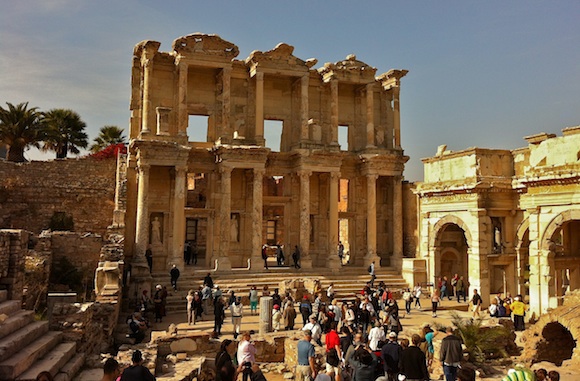
After the destruction caused by the Goths in 263 CE the city lay in ruin for over a hundred years. Not until the reign of emperor Constantine I in 395 would Ephesus see any effort to rebuild, but from this point would enjoy numerous renovations and additions under successive emperors and even rise to prominence as the second most important city in all the Byzantine Empire after Constantinople.
Unfortunately after the earthquake in 614 partially destroyed the city again, Ephesus slid further into decline as the harbor filled with silt and became inaccessible to the Aegean Sea. The majority of the inhabitants as a result left for the lower lying regions of the surrounding hills, using the ruins of the temples as building materials while marble sculptures were ground to powder for plaster. The decline only further hastened by successive Arab raids over the next century.
For the following three and half centuries it would be reduced to a small village, and while eventually being reincorporated back into the Byzantine Empire in 1100 it would instead be known as the town of Hagios Theologos. And for over two centuries it would remain under the empire’s protection, but thanks to its relatively close position to the nearby harbor, and more importantly position on the Mediterranean, Ephseus would again change hands when the region was conquered in 1304 and became part of the Aydinid principality that used the area to organize naval raids into neighboring regions.
For the majority of the following century the town would flourish as the new Seljuk rulers turned the town into a caravansary for passing traders, adding Turkish bathhouses and the Isa Bey Mosque. However it would repeatedly change hands through the early decades of the fifteenth century as the Ottomans contested control of the region, and eventually completely abandoned as the nearby harbor of Selcuk rose in prosperity.
![Ephesus and the Roman Empire [Repost]](http://www.cultureaddicthistorynerd.com/wordpress/wp-content/uploads/2012/05/celsus-columns-150x150.jpg)
![Ephesus sites: Library of Celsus [Repost]](http://www.cultureaddicthistorynerd.com/wordpress/wp-content/uploads/2013/09/celsus-library-150x150.jpg)
![Ancient ruins: Efes (Ephesus), Kusadasi [Repost]](http://www.cultureaddicthistorynerd.com/wordpress/wp-content/uploads/2011/12/gary_ephesus-150x150.jpg)
![The founding of Ephesus [Repost]](http://www.cultureaddicthistorynerd.com/wordpress/wp-content/uploads/2012/03/nic_columns-150x150.jpg)
![Abridged history of Messina, Sicily [Repost]](http://www.cultureaddicthistorynerd.com/wordpress/wp-content/uploads/2013/06/nic-messina-150x150.jpg)
![Ephesus: Ancient Christian Centre [Repost]](http://www.cultureaddicthistorynerd.com/wordpress/wp-content/uploads/2012/07/ephesus-mainstreet-150x150.jpg)



































